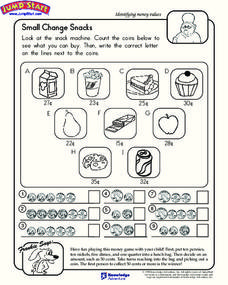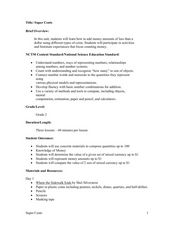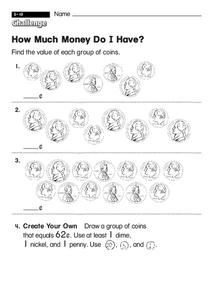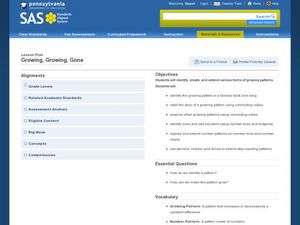Curated OER
Math Challenge
In this money worksheet, 2nd graders count coins. Students study quarters, dimes, nickels and pennies and write the amount show for 6 problems.
Curated OER
Money
In this counting change learning exercise, students look at 7 rows of various coins and then add up each row of coins. Students put their total amounts on the lines at the end of each row.
Curated OER
Money Counting Worksheet
In this counting money worksheet, students study the coins in each of 4 rows and count the amount of money they total. Students write the total amount.
Curated OER
Money Counting Worksheet
In this counting coins worksheet, students look at the coins in each row, total their amount, and write their total in the blank.
Curated OER
Money Counting Worksheet
In this counting coins activity, students look at the coins in each row, total their amount, and write their total in the blank.
Curated OER
Shopping for Candy
Students explore counting money. For this money counting and gingerbread house construction lesson, students use a calculator to determine how much and what type of candy they can buy given 25 cents. Students construct gingerbread...
Attainment Company
Money Skills
Young mathematicians learn to make sense out of money with this collection of skills practice worksheets. From identifying the different coins and bills in the US currency system, to counting money and correctly using the dollar and...
Curated OER
Susan's Choice
Young economists explore opportunity cost by counting how much money Susan has in her piggy bank. From here, they are challenged to help Susan make a choice about what she can buy with her money.
Curated OER
Small Change Snacks
In this counting coins worksheet, students count the value of the coins at the bottom and match them with the snack they can buy at the top. Students complete 9 problems and 9 matches.
Curated OER
What Can I Buy?
In this counting coins review worksheet, students examine 4 price tags in order to record the number of nickels and dimes needed to buy the item. Students also respond to 1 short answer question.
Curated OER
Super Cents
Second graders study money amounts less than a dollar. In this math instructional activity, 2nd graders practice counting coins. Students read various stories and discuss how money was used in the stories.
Curated OER
How Much is that Name?
Students explore money counting. In this money problem solving lesson, students calculate how much money their name is "worth" using the corresponding alphabet letters which have been assigned a coin value.
Curated OER
Create and Solve
In this early childhood math practice worksheet, students use problem solving skills to solve 6 story problems that require them to count coins.
Curated OER
Seeing Numbers In Tens And Ones
Second graders develop the skill of place values up to the tens place. They practice identifying the values of 2 digit numbers and writing the correlating values with counting. They use the example of money to make the lesson more...
Curated OER
My Test Book: Money
For this online interactive math skills worksheet, students solve 10 multiple choice math problems that require them to count coins. Students may submit their answers to be scored.
Curated OER
How Much Money Do I Have?
In this counting coins activity, students solve 4 problems in which a set of coins is counted. Students write the total value of the set of coins. Included on this page are pennies, nickels and dimes only.
Curated OER
Adding Instruments
In this counting money worksheet, students practice their math skills as they examine the prices of 3 items and respond to 4 questions that require then to count money.
Curated OER
How Much More?
In this counting coins worksheet, learners color the coins that match the given money amount for each child. Students then color the coins each child will use, but color the fewest number of coins possible.
Curated OER
Money: Demonstrating Coin Value up to $1.00
Students examine coin values up to $1.00 using paper coins. In this coin value lesson, students compare and contrast various coins to aid in identification, sort coins from smallest to largest, and match an equal number of pennies to...
Curated OER
Count Coins and Bills
Students study the names and values of different denominations of paper money, count sets of money that include both coins and bills. They complete a money chart, read and solve word problems.
Curated OER
"Let's Count Money"
Students participate in an interactive Internet activity that allows them to practice counting money. Students can work independently or cooperatively as they "drag and drop" coins using a mouse.
Curated OER
Jelly Beans for Sale
Students connect literature (story Jelly Beans for Sale by Bruce McMillan) to math concepts. In these estimating and money lessons, students work with jelly beans, unifix cubes, pennies, nickels, dimes, and quarters, to estimate and make...
Curated OER
Math Challenge: Coins
In this counting coins worksheet, students identify the coins and count the total. Students identify quarters, dimes, nickels, and pennies to complete the 6 problems.
Curated OER
Growing, Growing, Gone
Budding mathematicians identify growing patterns in numbers and songs then create their own patterns. They look at number patterns and language patterns and then create their own using money and footprints.

























